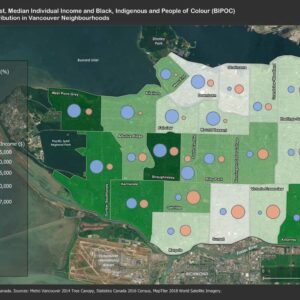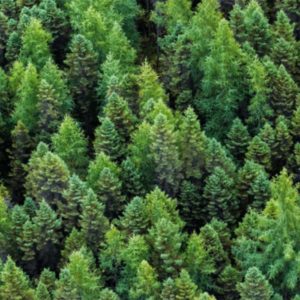Trees: Our Allies in Addressing Climate Change
Carbon is one of the most abundant elements in our atmosphere, and a major component of all living things. However, humans are drastically changing the balance of carbon within the earth’s systems by altering the land and by burning oil, coal, and natural gas. Together with phasing out fossil fuels and ramping up low-impact renewable energy, trees can actually decrease the amount of carbon in the atmosphere. This makes tree planting, among other actions such as restoring salt marshes or protecting wetlands, an important nature-based climate solution.
Trees naturally absorb carbon dioxide
Not only are trees incredible beings that provide food, shelter, and medicine to animals and humans alike, they also absorb, or ‘sequester’, carbon dioxide (CO2) from the atmosphere through the process of photosynthesis. Using water and sunlight, trees convert CO2 into sugars which are used to help the tree grow1. The remaining oxygen is then released back into the atmosphere.
Even as trees go through their natural life and death cycle the carbon is not entirely lost back into the air. As they decompose, the surrounding soil soaks up some of the carbon, which plays a vital role in keeping the soil healthy2. Soils need to remain intact in order to keep the carbon stored.
The greenhouse gases in our atmosphere can be thought of as a pile of garbage. The more humans emit the bigger the pile gets. The less humans emit, the pile stays the same. This is why trees are so important. Through tree planting, we can actually make the pile smaller. Trees really are amazing, aren’t they?
The carbon storage potential of trees
Recent research from ETH Zurich, Switzerland has identified reforestation as likely being one of the most effective strategies for tackling climate change3. Referencing this research, NASA suggests that atmospheric carbon can be reduced by about 25% if 500 billion trees are planted4. That is equal to eliminating half of all carbon emitted from human activity since 19605.
Canada plays an important role in global reforestation efforts. The research from ETF Zurich found that Canada is among six countries that hold over half the potential land for tree restoration work6. This highlights the importance of the Government of Canada’s commitment to plant 2 billion trees in the next 10 years7.
Smart Prosperity, an Ottawa-based think tank, has estimated that planting 2 billion trees by 2030 could sequester between 1.8 – 4 megatonnes of carbon dioxide emissions (Mt CO2e) each year starting around 20308. This is equivalent to taking 1,225,4569 cars, or 4%10 of all cars in Canada, off the road. By 2050, the Government of Canada projects that the 2 billion tree initiative will reduce greenhouse gas emissions by up to 12 Mt11. To put this in perspective, Canada emitted 729 Mt CO2 equivalent in 2018, and this number is expected to grow12. One of the key things to note is that the carbon storage benefits don’t kick in immediately. They need time to grow.
It takes time to reduce carbon pollution
What happens in 2030, 2050, and beyond depends on the choices we make today. Trees are no different. They take time to grow, which means they take time to sequester carbon.
As a sapling grows, it is able to absorb more and more CO2. For example, a tree bigger than 75 cm in diameter can absorb over 400% more carbon than a tree smaller than 45 cm in diameter every year13. This highlights the important role that large trees can play in sequestering carbon.
Different tree species also grow at different rates. Faster growing trees, like certain coniferous species, can absorb more carbon at younger ages, however, these trees die relatively sooner. In comparison, trees that grow slowly, such as oak, take longer to start storing carbon but sequester more over time compared to the trees that grow quickly14.
More than just carbon storage
Habitat destruction across Canada and the world, from rampant land-use change and deforestation, is the number one driver of biodiversity loss15. Climate change only exacerbates this problem. Thus even when done on a small scale, planting trees and forests can restore vital habitats for plants and animals16, helping to address the twin crises of climate change and species collapse at the same time.
In terms of severe weather, communities across Canada are projected to witness an increase in the severity and frequency of floods17, the number of days over 30°C18, and exposure to pollution and smog19— all as a result of climate change. Trees can help with all of this. Canopy cover helps prevent flooding by intercepting the rain, which allows up to 30% to evaporate without even touching the ground20. The green space needed for a tree provides a permeable surface in urban areas which reduces run-off21, and then the tree roots help the water penetrate the earth even faster22.
Furthermore, tree canopies provide shade, which cools the air, making cities more comfortable and reducing the need for air conditioning. Trees also improve the quality of the air. Hot temperatures bake car exhaust creating smog, but by increasing canopy cover in cities and towns, they can reduce the levels of pollution23.
Yeah, they can do all that, and more.
One part of the solution to climate change
The analogy of greenhouse gases in the atmosphere being a pile of garbage is important when thinking of all the ways to solve the devastation that results from a changing climate. Even though trees make the pile smaller, humans need to stop adding to the pile. Tree planting is not a substitute for phasing out fossil fuels.
- 1Forest Learning. (n.d.). How is carbon stored in trees and wood products? https://forestlearning.edu.au/images/resources/How%20carbon%20is%20stored%20in%20trees%20and%20wood%20products.pdf
- 2Cho, R. (2019, February 6). Can Soil Help Combat Climate Change? State of the Planet. https://blogs.ei.columbia.edu/2018/02/21/can-soil-help-combat-climate-change/
- 3Bastin, J. (2019a, July 5). The global tree restoration potential. Science Magazine. https://science.sciencemag.org/content/365/6448/76.full?ijkey=OxoPlV/Tcl1Ao&keytype=ref&siteid=sci
- 4 Buis, A. (2019, November 11). Examining the Viability of Planting Trees to Help Mitigate Climate Change. Climate Change: Vital Signs of the Planet. https://climate.nasa.gov/news/2927/examining-the-viability-of-planting-trees-to-help-mitigate-climate-change/
- 5Buis, A. (2019, November 11). Examining the Viability of Planting Trees to Help Mitigate Climate Change. Climate Change: Vital Signs of the Planet. https://climate.nasa.gov/news/2927/examining-the-viability-of-planting-trees-to-help-mitigate-climate-change/
- 6Bastin, J. (2019b, July 5). The global tree restoration potential. Science Magazine. https://science.sciencemag.org/content/365/6448/76
- 7 Government of Canada (n.d.). 2 Billion Trees Commitment. Government of Canada. https://www.canada.ca/en/campaign/2-billion-trees.html
- 8Sawyer, D., & Stiebert, S. (n.d.). There’s promise in planting billions and billions of trees. Smart Prosperity Institute (Formerly Sustainable Prosperity). https://institute.smartprosperity.ca/content/there-s-promise-planting-billions-and-billions-trees
- 9Greenhouse Gas Equivalencies Calculator. (n.d.). Natural Resources Canada. https://oee.nrcan.gc.ca/corporate/statistics/neud/dpa/calculator/ghg-calculator.cfm#results
- 10The Daily — Vehicle registrations, 2017. (n.d.). Statistics Canada. https://www150.statcan.gc.ca/n1/daily-quotidien/180615/dq180615e-eng.htm
- 11Natural Resources Canada. (2021, February 26). Minister O’Regan Launches Canada’s Plan to Plant Two Billion Trees. https://www.canada.ca/en/natural-resources-canada/news/2020/12/minister-oregan-launches-canadas-plan-to-plant-two-billion-trees.html
- 12Government of Canada, E. A. C. C. (n.d.). Greenhouse gas sources and sinks: executive summary 2020. Government of Canada. https://www.canada.ca/en/environment-climate-change/services/climate-change/greenhouse-gas-emissions/sources-sinks-executive-summary-2020.html
- 13Putting Down Roots for the Future. Urban Forest Management Plan 2018–2037. (2017, April). City of Ottawa. https://documents.ottawa.ca/sites/documents/files/final_ufmp_en.pdf
- 14Chamandy, A. (2021, April 8). Feds’ tree-planting program faces hurdles, with many questions left unanswered, say experts. The Hill Times. https://www.hilltimes.com/2020/12/09/feds-tree-planting-program-faces-hurdles-with-many-questions-left-unanswered-say-experts/275029
- 15Otto, S. (2015, March 3). Biodiversity Protects. Alternatives Journal. https://www.alternativesjournal.ca/politics-policies/biodiversity-protects/#:%7E:text=Habitat%20loss%20and%20degradation%20has,Pollution%20(41.1%20per%20cent)
- 16Canadian Wildlife Federation. (n.d.). Use Trees and Plants to Boost Biodiversity. https://cwf-fcf.org/en/resources/DIY/habitat-projects/map-your-backyard/use-trees-and-plants-to-boost.html
- 17Climate Atlas of Canada. (n.d.). Canadian Cities and Climate Change. https://climateatlas.ca/canadian-cities-and-climate-change
- [18]Climate Atlas of Canada. (n.d.-b). Very Hot Days (+30°C). https://climateatlas.ca/map/canada/plus30_2060_45#lat=43.58&lng=-84.41&z=5
- 19Climate Atlas of Canada. (n.d.). Canadian Cities and Climate Change. https://climateatlas.ca/canadian-cities-and-climate-change
- 20Trust, W. (n.d.). Can trees and woods help reduce flooding? Woodland Trust. https://www.woodlandtrust.org.uk/trees-woods-and-wildlife/british-trees/flooding/
- 21 ibid
- 22 ibid
- 23Climate Atlas of Canada. (n.d.). Canadian Cities and Climate Change. https://climateatlas.ca/canadian-cities-and-climate-change



